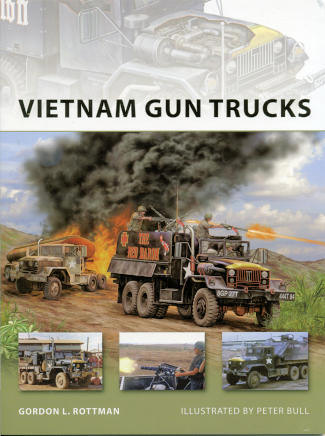 A New
Vanguard title that is on a piece of equipment that is a bit unusual and
fascinating in terms of its development and success is this one on the Vietnam
Gun Truck. It is truly a case of necessity being the mother of invention. During
the early years of the war in Vietnam, US cargo convoys had to go farther and
farther away from the main population centers to supply outlying camps and
posts. It did not take long for the VietCong to realize that this was an
opportunity to disrupt the US war effort.
A New
Vanguard title that is on a piece of equipment that is a bit unusual and
fascinating in terms of its development and success is this one on the Vietnam
Gun Truck. It is truly a case of necessity being the mother of invention. During
the early years of the war in Vietnam, US cargo convoys had to go farther and
farther away from the main population centers to supply outlying camps and
posts. It did not take long for the VietCong to realize that this was an
opportunity to disrupt the US war effort.
Thanks to the mostly dirt roads, convoys could not
travel quickly and it was easy to plant what we now call roadside bombs which
would detonate in a manner to trap the trucks behind the one blown up. This made
it easier to destroy or badly damage others in the convoy.
Because the Military Police were stretched thin, proper
convoy protection was not available and it became up to the Transportation
Companys to come up with an idea. This was the armed and armored truck. Using
mostly 2 1/2 ton trucks with two layers of 2x12s with sandbags in between, these
were armed with M60s. However, the M60 did not have all that great a penetrating
power and when the sandbags got wet, the weight put a huge strain on the truck.
So much that the gun trucks (as they were being called) would be the slow trucks
in the return convoy.
Eventually, things progressed to the point of where 5
ton trucks were included, armor became steel plate and a variety of heavy
caliber machine guns (mainly .50 cal M2s) were mounted. These crews became the
elite of the company and, along with paving many of the roads and improved
tactics, led to a greatly reduced rate of convoy disruption and loss.
Gordon Rottman tells us the story of these 'unofficial'
vehicles, how they were developed, how they were used and the men who crewed
them. He also covers many of the more interesting and intense missions performed
by these men. This is superbly illustrated by Peter Bull and is chock full of
photos of these interesting vehicles.
After the war, only one truck was saved for posterity
and is at the Transportation Museum at Ft. Eustis, VA. Most of the over 300 gun
trucks were converted back to cargo or passed on to the Vietnamese when the US
pulled out. There are many replicas out there, however. It is interesting to
note that the Army did not learn a lesson about these trucks for use in Iraq or
Afghanistan and aside from one vehicle, these successful vehicles were not
duplicated. Some surmise it was because no defense contractor would make money
from developing them as they did the less than successful up-armored Hummvee.
Overall, an excellent reference into this fascinating
and highly potent weapons system and one that you should get for your library.
September 2011
For more on the complete line of Osprey books,
visit www.ospreypublishing.com. In the US, it is
Osprey Direct at 44-02 23rd St, Suite 219, Long Island City, NY 11101., where you can
get a catalogue of available books.
If you would like your product reviewed fairly and quickly, please
contact
me or see other details in the Note to
Contributors.
 A New
Vanguard title that is on a piece of equipment that is a bit unusual and
fascinating in terms of its development and success is this one on the Vietnam
Gun Truck. It is truly a case of necessity being the mother of invention. During
the early years of the war in Vietnam, US cargo convoys had to go farther and
farther away from the main population centers to supply outlying camps and
posts. It did not take long for the VietCong to realize that this was an
opportunity to disrupt the US war effort.
A New
Vanguard title that is on a piece of equipment that is a bit unusual and
fascinating in terms of its development and success is this one on the Vietnam
Gun Truck. It is truly a case of necessity being the mother of invention. During
the early years of the war in Vietnam, US cargo convoys had to go farther and
farther away from the main population centers to supply outlying camps and
posts. It did not take long for the VietCong to realize that this was an
opportunity to disrupt the US war effort.